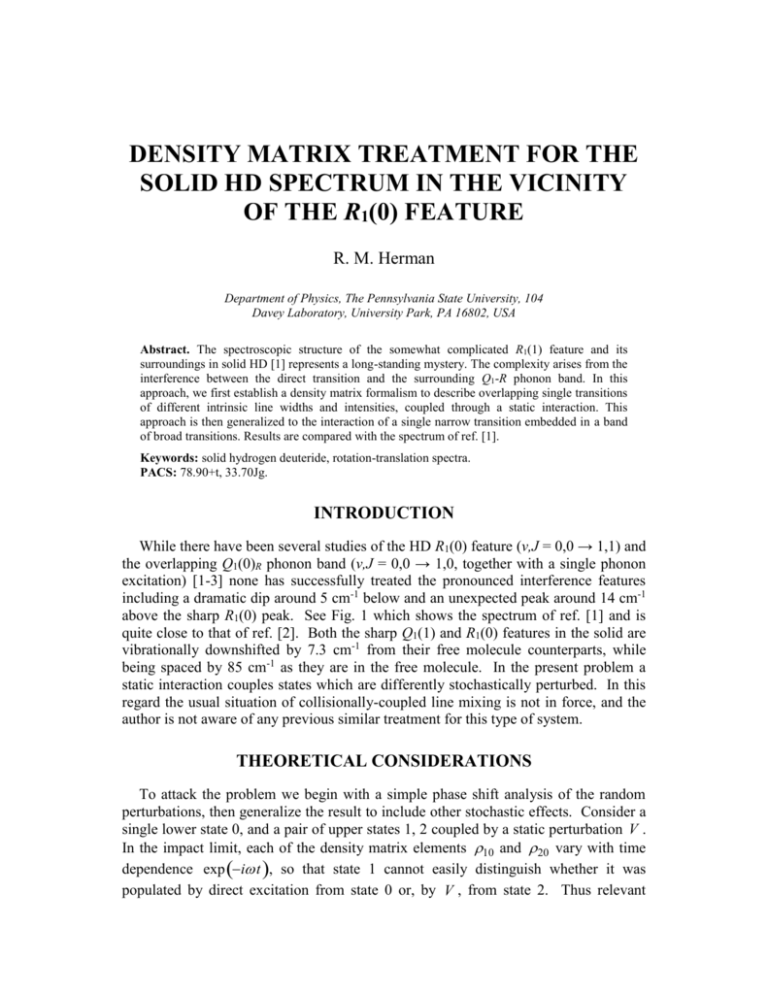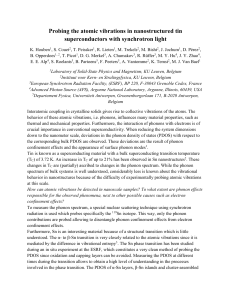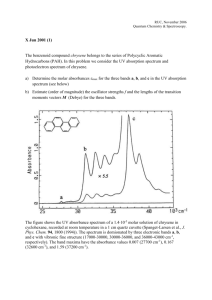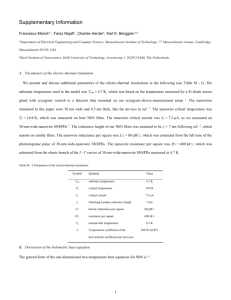DENSITY MATRIX TREATMENT FOR THE SOLID HD SPECTRUM
advertisement

DENSITY MATRIX TREATMENT FOR THE SOLID HD SPECTRUM IN THE VICINITY OF THE R1(0) FEATURE R. M. Herman Department of Physics, The Pennsylvania State University, 104 Davey Laboratory, University Park, PA 16802, USA Abstract. The spectroscopic structure of the somewhat complicated R1(1) feature and its surroundings in solid HD [1] represents a long-standing mystery. The complexity arises from the interference between the direct transition and the surrounding Q1-R phonon band. In this approach, we first establish a density matrix formalism to describe overlapping single transitions of different intrinsic line widths and intensities, coupled through a static interaction. This approach is then generalized to the interaction of a single narrow transition embedded in a band of broad transitions. Results are compared with the spectrum of ref. [1]. Keywords: solid hydrogen deuteride, rotation-translation spectra. PACS: 78.90+t, 33.70Jg. INTRODUCTION While there have been several studies of the HD R1(0) feature (v,J = 0,0 → 1,1) and the overlapping Q1(0)R phonon band (v,J = 0,0 → 1,0, together with a single phonon excitation) [1-3] none has successfully treated the pronounced interference features including a dramatic dip around 5 cm-1 below and an unexpected peak around 14 cm-1 above the sharp R1(0) peak. See Fig. 1 which shows the spectrum of ref. [1] and is quite close to that of ref. [2]. Both the sharp Q1(1) and R1(0) features in the solid are vibrationally downshifted by 7.3 cm-1 from their free molecule counterparts, while being spaced by 85 cm-1 as they are in the free molecule. In the present problem a static interaction couples states which are differently stochastically perturbed. In this regard the usual situation of collisionally-coupled line mixing is not in force, and the author is not aware of any previous similar treatment for this type of system. THEORETICAL CONSIDERATIONS To attack the problem we begin with a simple phase shift analysis of the random perturbations, then generalize the result to include other stochastic effects. Consider a single lower state 0, and a pair of upper states 1, 2 coupled by a static perturbation V . In the impact limit, each of the density matrix elements 10 and 20 vary with time dependence exp i t , so that state 1 cannot easily distinguish whether it was populated by direct excitation from state 0 or, by V , from state 2. Thus relevant relaxation properties must reflect the excitation pathway, and not simply the two states indicated in the specification of the density matrix element. One therefore must d separate 10 into a sum of a directly excited part 10 coming from the almost 100% i populated state 0, and an indirectly excited part 10 coming from state 2. We write the corresponding Liouville equations (with all energies as circular frequencies) i 10 d 10 10t 10 d C10 exp i t (1) i i i 10 10 v12t 10 V12 20 d 20 i (2) with 10 t V11 t V00 t coll , 12 t V11 t V22 t coll , and C10 1 Ep10 . 2 and 20i . To solve Eq. (1) in the impact Corresponding equations exist for 20 d regime, write t 10 d 10 d exp i 10t 10 t dt (3) with the result t 10 d iC10 exp i 10 t i 10 t dt (4) This equation can be converted into a difference equation connecting time intervals large compared with a collision duration, and then be directly integrated as in conventional impact theory with the result, (when one gets back to 10 d ), 10 d iC10 exp i t 10 / 2 i 10 10 (5) with 10 and 10 being the standard linewidth and shift for the 10 transition by itself, leading to the expected Lorentz profile in the absence ofV12 . This result and similar ones for other components, could have been obtained with the equivalent equations (6) 10 / 2 i 10 10d iC10 exp i t 12 /2 i10 10i iV12 20d 20i 20 / 2 i 20 20d iC20 exp i t 21 /2 i 20 20i iV2110d 10i (7) (8) (9) with line shift parameters neglected and the stochastic effects simply represented by effective parameters throughout. This is often done in other relaxation analyses, where these parameters now reflect all sources of broadening. Here 12 21, while possibly differing from 10 and 20. An interesting (and necessary) feature of Eqs. (6-9) is that in the event that the ’s are equal and small, the usual results for intensities and line positions of the coupled states 1,2 as being directly excited from the 0 state are obtainable for all values of V12 and 20 10 . One now proceeds by allowing state 2 to be replaced by a continuum of states k, and on the r.h.s. of Eq. (7), one sums over all states k. Substitution of the solution of Eq. (8) and the form for Eq. (9) into Eq. (7) and combining with Eq. (6), one can get a closed form solution for 10 d 10i . Then substituting that result into Eq. (9), 20i can be established. The results can be written as a (rather complicated) function of the noninterfered phonon spectrum, the unperturbed R1(0) Lorentzian and an interaction-perturbed R1(0) Lorentzian, together with their (Kramers-Kronig) dispersion counterparts. RESULTS The results of the present treatment are shown in Fig. 1, together with the spectrum of ref. [1]. The best guess for a smoothed, noninterfering HD phonon spectrum, consistent with the known D2 phonon spectrum [1] is also shown. This is then used in the calculation of the total response, as indicated above FIGURE 1. The observed [1] total spectrum , the proposed smoothed uninterfered phonon spectrum inferred from that of D2 [1] , and resulting predicted total contour for parameters C10= 6.0, (V1k/C10C1k) = 0.060, 10 = 1.5 and 1k = k1 = 12. These results are preliminary, and more study on both the methodology and correct noninterfered phonon spectrum are needed. ACKNOWLEDGEMENT The author is pleased to acknowledge helpful discussions with R. H. Tipping and with J. C. Lewis. REFERENCES 1. A. Crane, and H. P. Gush, Can. J. Phys. 44, 373-398 (1976). 2. A. R. W. McKellar, and M. J. Clouter, Can. J. Phys 68, 422-427 (1990). 3. J. D. Poll, R. H. Tipping, Sang Young Lee, Sung-ik Lee, Tae W. Noh and J. R. Gaines, Phys. Rev. B 39, 1137211377 (1989), and references therein.











